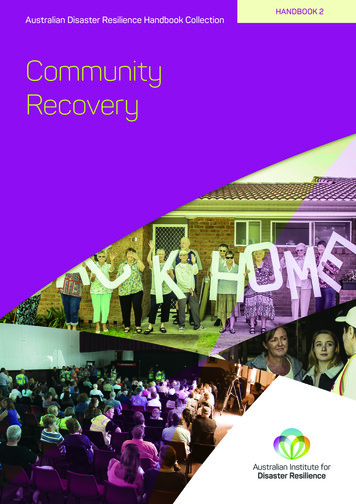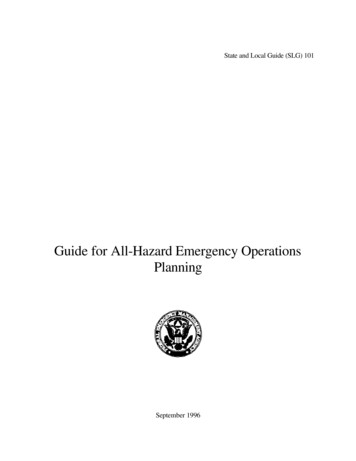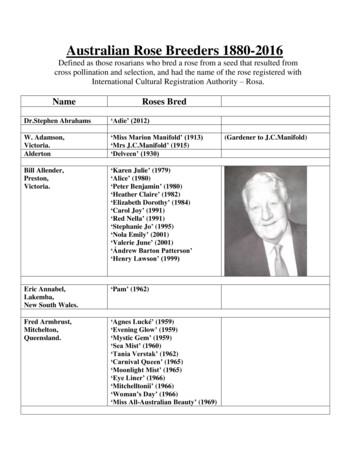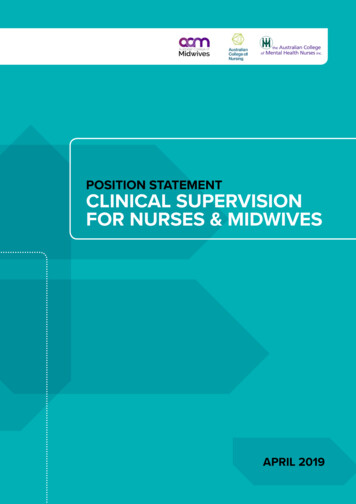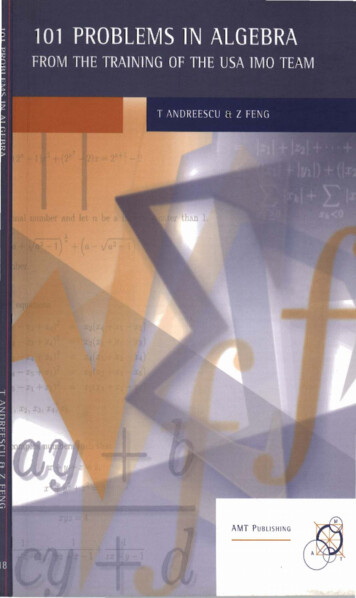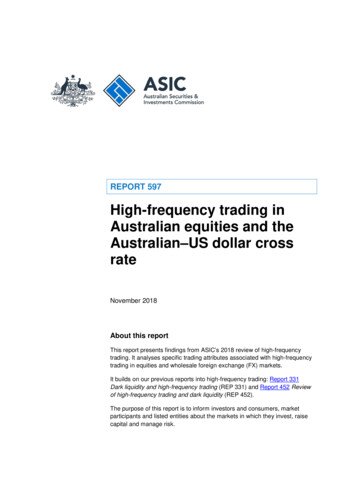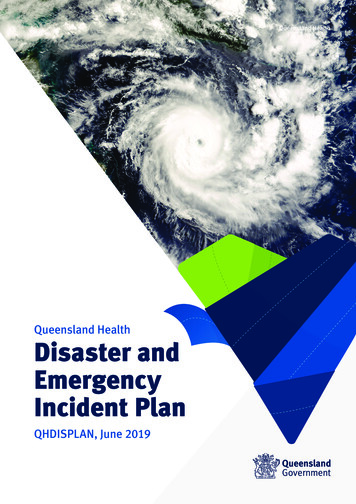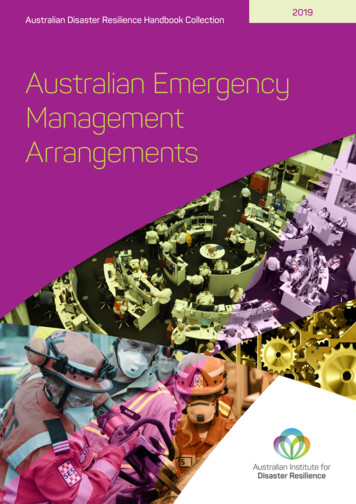
Transcription
Australian Disaster Resilience Handbook CollectionAustralian EmergencyManagementArrangements2019
Cover images, clockwise from top: Incident control room (photo NSW Rural Fire Service); cogs (photo: Envato Elements);SES demonstration at an International Women's Day event, Melbourne 2019 (photo: Alana Beitz, AFAC).
AUSTRALIAN DISASTER RESILIENCEHANDBOOK COLLECTIONAustralian EmergencyManagement ArrangementsThird Edition 2019Australian Emergency Management Arrangements Handbooki
Commonwealth of Australia 2019AttributionEdited and published by the Australian Institutefor Disaster Resilience on behalf of the AustralianGovernment Department of Home Affairs.Where material from this publication is used for anypurpose, it is to be attributed to the developer as follows:Cover images, clockwise from top: Incident control room(photo: NSW Rural Fire Service); cogs (photo: EnvatoElements); SES demonstration at an InternationalWomen's Day event, Melbourne 2019 (photo: Alana Beitz,AFAC).CopyrightThe Australian Institute for Disaster Resilienceencourages the dissemination and exchange ofinformation provided in this publication.The Commonwealth of Australia owns the copyright in allmaterial contained in this publication unless otherwisenoted.Where this publication includes material, whosecopyright is owned by third parties, the AustralianInstitute for Disaster Resilience has made all reasonableefforts to: clearly label material where the copyright is owned bya third party ensure that the copyright owner has consented tothis material being presented in this publication.Wherever a third party holds copyright in materialpresented in this publication, the copyright remains withthat party. Their permission is required to reproduce thematerial.All material presented in this publication is providedunder a Creative Commons Attribution 4.0 InternationalPublic License, with the exception of: the Commonwealth Coat of ArmsSource: Australian Emergency ManagementArrangements Handbook (AIDR 2019).Using the Commonwealth Coat of ArmsThe terms of use for the Coat of Arms are availablefrom the It’s an Honour website: ries regarding the content, licence and any use ofthis document may be directed to:Australian Institute for Disaster Resilience370 Albert Street, East Melbourne Vic 3002Telephone 61 (0) 3 9419 2388DisclaimerThe Australian Government Department of Home Affairsand the Australian Institute for Disaster Resilience, inconsultation with emergency management professionalsand subject matter experts, exercised care in thecompilation and drafting of this publication; however, thedocument and related graphics could include technicalinaccuracies or typographical errors and the informationmay not be appropriate to all situations.In no event shall the Commonwealth of Australia(acting through the Department of Home Affairs) orthe Australian Institute for Disaster Resilience be liablefor any damages whatsoever, whether in an action ofcontract, negligence or other tortious action, arising outof or in connection with the use of or reliance on any ofthe information in this publication.registered trademarks, including the Australian Government Department of HomeAffairs logo the Australian Institute for Disaster Resiliencelogomaterials specifically mentioned as not beingprovided under a Creative Commons Attribution 4.0International Public Licencecontent supplied by third parties.Details of the relevant licence conditions are availableon the Creative Commons Attribution 4.0 website (www.creativecommons.org.au) as is the full legal code for theCC BY 4.0 license.iiAustralian Emergency Management Arrangements Handbook
Australian DisasterResilience HandbookCollectionThe Australian Disaster Resilience Handbook Collectionprovides guidance on national principles and practices fordisaster resilience.The Handbook Collection: provides an authoritative, trusted and freely availablesource of knowledge about disaster resilienceprinciples in Australia aligns national disaster resilience strategy and policywith practice, by guiding and supporting jurisdictions,agencies, other organisations and individuals in theirimplementation and adoption highlights and promotes the adoption of goodpractice in building disaster resilience in Australia builds interoperability between jurisdictions, agencies,the business sector, local businesses and communitygroups by promoting the use of a common languageand coordinated, nationally agreed principles.The Handbook Collection is developed and reviewedby national committees representing a range of stateand territory agencies, governments, organisations andindividuals involved in disaster resilience. The collection issponsored by the Australian Government, Department ofHome Affairs through Emergency Management Australia.Access to the Handbook Collection and further details areavailable on the Australian Disaster Resilience KnowledgeHub (the Knowledge Hub) at www.knowledge.aidr.org.au/handbooks.Australian Emergency Management ArrangementsCommunicating with People with a Disability: National Guidelines for Emergency ManagersCommunities Responding to Disasters: Planning for Spontaneous VolunteersCommunity RecoveryEvacuation PlanningHealth and Disaster ManagementIncident Management in AustraliaLand Use Planning for Disaster Resilient CommunitiesLessons ManagementManaging ExercisesManaging the Floodplain: A Guide to Best Practice in Flood Risk Management in AustraliaNational Emergency Risk Assessment Guidelines (NERAG)National Strategy for Disaster Resilience: Community Engagement FrameworkPublic Information and WarningsSafe and Healthy Crowded PlacesTsunami Emergency Planning in AustraliaiiiAustralian Emergency Management Arrangements Handbook
AcknowledgementsThis handbook was made possible through thesupport of a broad cross-section of the disasterresilience and emergency management sector.AIDR also acknowledges the contribution and oversightby members of the Australia-New Zealand EmergencyManagement Committee.AIDR thanks Euan Ferguson AFSM for writing thehandbook.Working Group membersAIDR acknowledges the expert guidance from theworking group in developing this handbook.Australian Local Government Association – MonicaTelesny, Senior Policy AdvisorAustralian Red Cross – John Richardson, NationalResilience ManagerDepartment of the Chief Minister, Northern Territory– Paul Terawsky, formerly Director, Security andEmergency RecoveryDepartment of Fire and Emergency Services, WesternAustralia – Muriel Leclercq, Director, AssuranceEmergency Management Australia – Steve Dwyer,Assistant Director, Disaster Preparedness; Faruk Yay,Assistant Director, Public Safety Communicationsand Kelly Grocock, Policy Officer, Public SafetyCommunicationsAIDR also acknowledges the support and input ofthe following individuals and organisationsAustralian Capital Territory Emergency Services Agency– Nick Lhuede, Senior Director, Risk and PlanningDepartment of Fire and Emergency Services, WesternAustralia - Peta Turner Principal Policy Officer; AbbySimons, Senior Policy Officer and Matt Verney, PrincipalPolicy OfficerNorthern Territory Police, Fire and Emergency Services David Willing, Executive Director, Northern Territory Fire,Rescue and Emergency ServicesOffice of Emergency Management, New South Wales– Ben Millington, Chief Superintendent, EmergencyManagement Coordination and Ivan Mills, Policy Officer,Emergency Management CoordinationSouth Australian Fire and Emergency ServicesCommission – Brenton Keen, Director, EmergencyManagement OfficeSouth Australia Police – Senior Sergeant First ClassRussell Dippy, Emergency Management Coordinator,Emergency and Major Event SectionQueensland Fire and Emergency Services - John Rolfe,Director, Community Resilience and Risk Mitigation;Adam Green, Executive Manager, Hazard and Risk Unitand Wayne Hepple, Executive Manager, Severe WeatherMitigationEmergency Management Victoria – Susan Fayers,Manager, Emergency Management DoctrineOffice of Emergency Management, New South Wales– Bronwyn Weir, Principal Policy Analyst EmergencyManagement CoordinationQueensland Fire and Emergency Services – Kevin Walsh,Assistant Commissioner, Emergency Management &Community CapabilitySouth Australian Fire and Emergency ServicesCommission – Linda Haskins, Senior Project Officer,Emergency ManagementTasmania State Emergency Service – Cheryl Ames,Projects Coordinator, Emergency Management UnitivAustralian Emergency Management Arrangements Handbook
ContentsAustralian Disaster Resilience Handbook Collection iiiAcknowledgements ivExecutive summary viIntroduction 1Principles of emergency management 1Chapter 1: Legal and administrative framework National Strategy for Disaster Resilience Sendai Framework for Disaster Risk Reduction 2015-2030 National Disaster Risk Reduction Framework PPRR - prevention, preparedness, response and recovery Response and recovery arrangements Roles and responsibilities of governments A shared approach 34455579Chapter 2: Prevention and mitigation 15Chapter 3: Preparedness 17Emergency planning 18Chapter 4: Response 19Incident management 20Relief 21Chapter 5: Recovery Recovery principles Early recovery Medium to long-term recovery Transition Recovery arrangements 222323242424Chapter 6: Catastrophic disasters 25Australian state and territory emergency management plans 27References 28List of FiguresFigure 1: Governance structure for the National Strategy for Disaster Resilience (COAG 2011) 5List of TablesTable 1: Principles of emergency management 2Table 2: Features of emergencies of increasing impact 6vAustralian Emergency Management Arrangements Handbook
Executive summaryGlobally, losses from natural and human caused hazardsare increasing. The factors affecting this impact arevaried and complex and include: increasing population improved standards of living and a rapidly growingmiddle class increasing concentration of people and assets inurban areas settlement and industrialisation of vulnerable areas(such as coastal zones and flood plains) increased complexity and interdependencies insupply chains, and intensification and accumulation of extreme weatherevents.Australia is not immune from these factors. These trendsmay increase the vulnerability to, and the impacts of,emergencies and disasters.To help prepare for a future that is complexand uncertain, the Australian EmergencyManagement Arrangements Handbook(AIDR 2019) has been prepared to articulatethe national arrangements for emergencymanagement within Australia and its states andterritories.The handbook establishes a set of principles that areintended to underpin and guide emergency managementactivities.It also describes the emergency management rolesand responsibilities of all levels of government,non-government organisations (NGOs), businesses,communities and individuals.Arrangements and responsibilities for the comprehensiveapproach to emergency management - prevention,preparedness, response and recovery (PPRR) arediscussed.These arrangements support emergency managementin Australia through the concepts of an 'all hazards'approach and 'shared responsibility'.viPurpose of the AustralianEmergency ManagementArrangementsThe Australian Emergency Management Arrangements(the Arrangements) are intended to guide Australiangovernments, non-government organisations,emergency management organisations, agencies,and communities in establishing their emergencymanagement arrangements. They articulate theprinciples, structures and procedures that supportnational coordination of emergency management.The purpose of the Arrangements is to provide a highlevel, scalable overview of how Australia addresses therisks and impacts of hazards through a collaborativeapproach to the prevention of, preparedness for,response to and recovery from emergencies.The principles and structures herein also supportAustralians affected by emergencies overseas and allowthe Australian government to assist (if requested by)foreign governments affected by emergencies and forassistance to be received from foreign governments.The Arrangements outline the collaboration necessary toaddress the nature and scale of different emergencies.This handbook is intended to: be the authoritative and trusted source of knowledgeof the emergency management arrangements inAustralia provide nationally agreed principles that underpinemergency management arrangements in Australia identify and promote the adoption of good practice inemergency management arrangements build interoperability between jurisdictions, agencies,businesses, communities and individuals by theapplication of the principles and common language,and align national disaster resilience strategies,frameworks and policy with emergency managementarrangements by informing and assisting jurisdictions,agencies, businesses, communities and individualsin the implementation and adoption of thesearrangements.Australian Emergency Management Arrangements Handbook
The purpose of the handbook is not to specifythe management of an emergency in responseto a specific event or disaster. However, theunderpinning principles provide a context forguiding the approach to these situations.Emergencies can and do happen on a daily basis. In somecases the size, scale, impact, complexity or consequenceof an emergency is such that the emergency isconsidered a disaster.ContextDisaster: A serious disruption of the functioning of acommunity or a society at any scale due to hazardousevents interacting with conditions of exposure,vulnerability and capacity, leading to one or more of thefollowing: human, material, economic or environmentallosses and impacts (Australian Government Departmentof Home Affairs 2018).This handbook is one of the Australian National DisasterResilience Handbook Collection.There is jurisdictional variation in the use of the terms'emergency' and 'disaster'.This handbook is intended to complement otherhandbooks in the collection. Community Recovery(AIDR 2018) is an important reference that supportsthis handbook.Catastrophic disaster: Is what is beyond our currentarrangements, thinking, experience and imagination(i.e. that has overwhelmed our technical, non-technicaland social systems and resources, and has degradedor disabled governance structures and strategic andoperational decision-making functions) (AustralianGovernment Department of Home Affairs 2018). Itshould be noted that severe to catastrophic disastersdiffer from emergencies in that they exceed business asusual emergency management systems and capabilitydesign parameters.This handbook reflects the intent and content of theNational Strategy for Disaster Resilience (COAG 2011),Australia’s commitment to the Sendai Frameworkfor Disaster Risk Reduction 2015-2030 (the SendaiFramework) and the National Disaster Risk ReductionFramework (Australian Government Department of HomeAffairs 2018).It updates and replaces the 2014 edition of AustralianEmergency Management Arrangements. The handbookis published by the Australian Institute for DisasterResilience, on behalf of the Australian GovernmentDepartment of Home Affairs.This 2019 edition of Australian Emergency ManagementArrangements was reviewed, edited and updatedduring 2018 and 2019. A working group includingrepresentatives from each Australian state and territorywas established to review the handbook and provideinput into the revised content.ScopeIt is important to define the terms 'emergencymanagement', 'emergency' and 'disaster' as these termsare used frequently in this handbook.Emergency management: A range of measures tomanage risks to communities and the environment;the organisation and management of resources fordealing with all aspects of emergencies. Emergencymanagement involves the plans, structures andarrangements which are established to bring togetherthe normal endeavours of government, voluntary andprivate agencies in a comprehensive and coordinatedway to deal with the whole spectrum of emergencyneeds including prevention, response and recovery(COAG 2011).Emergency: An event, actual or imminent, whichendangers or threatens to endanger life, property orthe environment, and which requires a significant andcoordinated response (AIDR 2019).viiThese Arrangements: outline the principles and structures that supportnational coordination of emergency management inAustralia and its off-shore territories recognise that states and territories have the primaryrole for emergency management support the concept of an 'all hazards' approach support the concept of 'shared responsibility' are intended to support, not supersede or conflictwith, specific sector or hazard specific guidancewhere it exists.The role of the Australian Govermnment is to providesupport and assistance to the jurisdictions. TheAustralian government, states and territories andlocal governments may have their own legislationand administrative arrangements for emergencymanagement. The intent of this handbook is to supportand reinforce these arrangments. It is intended for useand guidance by emergency management professionalsin governments at every level, agencies (including notfor-profit entities), businesses and communities.The handbook should be read in conjunction with theNational Strategy for Disaster Resilience, the SendaiFramework and the National Disaster Risk ReductionFramework.The Arrangements will be reviewed and reissued at leastevery three years or more frequently for major changes.The Australia-New Zealand Emergency ManagementCommittee (ANZEMC) will oversee revisions and theDirector General Emergency Management Australia,Department of Home Affairs, approves the publication ofthe Handbook.Australian Emergency Management Arrangements Handbook
IntroductionAustralians expect governments at all levelsto work together with communities in buildingresilience to emergencies. Where emergenciesoccur, communities should be well servedby prevention and mitigation plans and bypreparedness, response, relief and recoveryarrangements that are effective and forwardthinking.Under Australia’s constitutional arrangements, stateand territory governments have primary responsibilityfor the protection of life, property and the environmentwithin their jurisdiction (refer to www.aph.gov.au/aboutparliament/senate/powers practice n procedures/constitution). All levels of government acknowledgethat the impact of some emergencies will be particularlysevere or widespread and may exceed the capability of asingle state or territory.Australia’s emergency management arrangements bringtogether the efforts of the Australian, state, territoryand local governments, non-government organisations,businesses, communities and individuals to delivercoordinated emergency management across all hazards.These Arrangements rely on a high level of trust andcooperation between all parties. They reflect the resultof shared experiences in dealing with and learninglessons from past emergencies and activities such astraining exercises.1The Council of Australian Governments (COAG) hasfocused on a resilience and risk reduction-basedapproach to emergency management policy, whichis aimed at enhancing resilience so that Australiansand their communities are resilient and better able towithstand and recover from emergencies.Internationally, Australia forms strategic partnershipsfor mutual international assistance arrangementsto mitigate or reduce the impact of emergenciesdomestically and globally, particularly in Australia’s regionof interest.Principles of emergencymanagementAustralia’s approach to the management of emergenciesis guided by a number of high-level principles that areintended to provide guidance, flexibility and a broadunderstanding of the approaches to emergencymanagement. The goal of these principles is to improveand provide consistency in policy and decision makingand to support resilience to emergencies and disasters inAustralia.An explanation of the emergency management principlesfollows:Australian Emergency Management Arrangements Handbook
Table 1: Principles of emergency managementPrincipleExplanationPrimacy of lifeThe protection and preservation of human life (including both communities and emergency servicepersonnel) and relief of suffering will be paramount over all other objectives and considerations.ComprehensiveThe development of emergency management arrangements will embrace the phases of prevention,preparedness, response, and recovery (PPRR) across all hazards. These phases of emergencymanagement are not necessarily sequential.CollaborativeRelationships between emergency management stakeholders and communities are based on integrity,trust and mutual respect, building a team atmosphere and consensus. Planning and systems of workreflect common goals and all stakeholders work with a unified effort.CoordinatedThe bringing together of organisations and other resources to support emergency management response,relief and recovery. It involves the systematic acquisition and application of resources (organisational,human and equipment) in an emergency situation. Activities of all stakeholders are synchronised andintegrated. Information is shared to achieve a common purpose and impacts and needs are continuouslyassessed and responded to accordingly.FlexibleEmergency situations are constantly changing. Emergency management decisions may require initiative,creativity and innovation to adapt to new and rapidly emerging challenges. Emergency plans need to beagile to change and adapt to these new circumstances.Risk basedEmergency managers use sound risk management principles and processes in prioritising, allocating andmonitoring resources to manage the risks from hazards. Risk based planning will anticipate the effect ofefforts, the changing hazard landscape and the changing consequences of the emergency.SharedresponsibilityEveryone understands their own responsibility in an emergency, and the responsibility of others.Communities and individuals understand the risk. This encourages all stakeholders to prevent, prepare for,and plan for how they will safely respond to and recover from an emergency situation.ResilienceThe ability of a system, community or society exposed to hazards to resist, absorb, accommodate, adaptto, transform and recover from the effects of a hazard in a timely and efficient manner, including throughthe preservation and restoration of its essential basic structures and functions through risk management(UNDRR 2017).CommunicationInformation is crucial to decision making and to the preservation of life. Emergency managers need tosupport common information systems and are responsible for providing and sharing clear, targeted andtailored information to those who need it, and to those at risk, to enable better decision making by allstakeholders.IntegratedEmergency management efforts must be integrated across sectors, not progressed in silos, ensuring theengagement of the whole of governments, all relevant organisations and agencies, the business sectorand the community.ContinualimprovementAll sectors continuously learn and innovate to improve practices and share lessons, data and knowledgeso that future emergency management is better and the overall cost of impact of emergencies anddisasters is reduced. Continuous monitoring, review and evaluation should examine the processes,timelines and outcomes of plans. Review informs communities and displays transparency andaccountability. Review also enables facilitation of the adaptive change process with communities.2Australian Emergency Management Arrangements Handbook
Chapter 1: Legaland administrativeframework3
Key points The underpinning strategy for Australia’sapproach to emergency management is theNational Strategy for Disaster Resilience(COAG 2011). The Sendai Framework for Disaster RiskReduction and the National Disaster RiskReduction Framework support disaster riskreduction activities in Australia. The Australia-New Zealand EmergencyManagement Committee (ANZEMC) isresponsible for influencing and advocatingfor national policies and capabilities thatreduce the risk of emergencies, minimise thepotential for harm and uphold public trustand confidence in emergency managementarrangements. Australian emergency managementarrangements are scalable and underpinnedby partnerships at every level.Australia’s approach to emergencymanagement is guided by a set of principles.IntroductionState and territory g
handbook. Working Group members AIDR acknowledges the expert guidance from the working group in developing this handbook. Australian Local Government Association – Monica Telesny, Senior Policy Advisor Australian Red Cross – John Richardson, National Resilience Man
